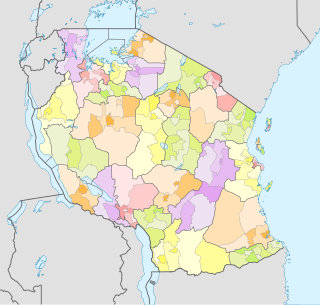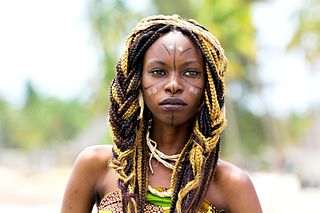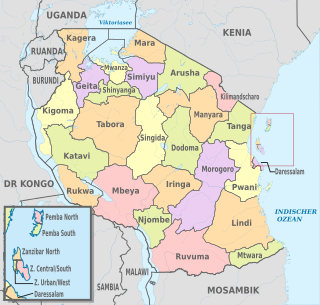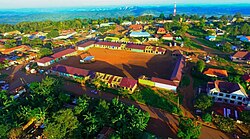
Tanzania is administratively divided into thirty-one regions.

Kagera Region is one of Tanzania's 31 administrative regions. The region covers an area of 35,686 km2 (13,778 sq mi). The region is comparable in size to the land area of the Netherlands. Kagera Region is bordered to the east by Lake Victoria, Mwanza Region and Mara Region. The region is bordered to the south by Geita Region and Kigoma Region. Lastly, Kagera borders Rwanda to the west, Uganda to the north and Burundi to the south west. The regional capital city is Bukoba. According to the 2022 national census, the region had a population of 2,989,299, an increase from 2,458,023 recorded in 2012.

Kigoma Region is one of Tanzania's 31 administrative regions, with the city of Kigoma as the reigonal capital. Kigoma Region borders Kagera Region, Geita Region, Katavi Region, Tabora Region, DRC and Burundi According to the 2012 national census, the region had a population of 2,127,930, which was higher than the pre-census projection of 1,971,332. For 2002–2012, the region's 2.4 percent average annual population growth rate was tied for the fourteenth highest in the country. It was also the sixteenth most densely populated region with 57 people per square kilometer. With a size of 45,066 square kilometres (17,400 sq mi), the region is slightly smaller than Estonia.

Muleba is one of the six districts of the Kagera Region of Tanzania. It is bordered to the north by Bukoba Urban and Bukoba Rural districts, to the south by Biharamulo District, to the east by Lake Victoria and to the west by Ngara and Karagwe districts. The district covers area of 3,518 square kilometres (1,358 sq mi).

Biharamulo District is one of the eight districts of the Kagera Region of Tanzania. It is bordered to the north by Karagwe District and Muleba District, to the east and south by Geita Region, to the west by Ngara District, and to the southwest by the Kigoma Region. Its administrative seat is Biharamulo town. Biharamulo Game Reserve is located within the borders of the district.

Ngara District is one of the eight districts of the Kagera Region of Tanzania. It is bordered to the north by Karagwe District, to the east by Biharamulo District, to the south by the Kigoma Region, to the northeast by Muleba District and to the west by the countries of Rwanda and Burundi.

As of 2021, there are 31 regions of Tanzania which are divided into 184 districts.
The Nyambo, or Ragwe, are a Bantu ethnic and linguistic group based in the Karagwe and Kyerwa Districts of Kagera Region in far northwestern Tanzania. The Nyambo population is estimated to number 670,000. Their boardering tribes are the Haya and Hangaza in Tanzania, Nyankole in Uganda and Rwanda with some similarities in their languages and a lot of differencies.

The Haya are a Bantu ethnic group based in Kagera Region, northwestern Tanzania, on the western side of Lake Victoria. With over one million people, it is estimated that Haya make up approximately 4% of the population of Tanzania. Historically, the Haya have had a complex kingship-based political system. Agriculture, particularly banana farming, is central to Haya economic life. They are credited with the independent development of carbon steel dating to 2000 years ago using pre-heating techniques.

The following outline is provided as an overview of and topical guide to Tanzania:

The administrative divisions of Tanzania are controlled by Part I, Article 2.2 of the Constitution of Tanzania. Tanzania is divided into thirty-one regions. Each region is subdivided into districts. The districts are sub-divided into divisions and further into local wards. Wards are further subdivided for management purposes: for urban wards into streets and for rural wards into villages. The villages may be further subdivided into hamlets.

Coffee production in Tanzania is a significant aspect of its economy as it is Tanzania's largest export crop. Tanzanian coffee production averages between 30,000 and 40,000 metric tons annually of which approximately 70% is Arabica and 30% is Robusta.

Geita Region is one of Tanzania's 31 administrative regions. The region covers an area of 20,054 km2 (7,743 sq mi)."Geita Region Size". The region is comparable in size to the combined land area of the nation state of Slovenia. Geita Region is bordered to the east by Lake Victoria, Mwanza Region and Shinyanga Region. The region is bordered by Tabora Region and Kigoma Region to the south and south west respectively. Lastly, Gieta is borders Kagera Region to the west.

Chato District is one of the five districts in Geita Region of northwestern Tanzania. Its administrative centre is the town of Chato. The main ethnic group in the district are the Sukuma. The late John Magufuli, who used to be as President of Tanzania from 2015—2021, was born in Chato.

Bukoba Rural District is one of the eight districts of the Kagera Region of Tanzania. It is bordered to the north by Missenyi District, to the east by Lake Victoria and Bukoba Urban District, to the south by Muleba District and to the west by Karagwe District. Its administrative seat is Bukoba town.

Bukoba Urban District is one of the eight districts of the Kagera Region of Tanzania. It is bordered to east by Lake Victoria and to the west by Bukoba Rural District. Its administrative seat is the town of Bukoba.

Kyerwa District is one of the eight districts of the Kagera Region of Tanzania. It is one of the 20 new districts formed in Tanzania since 2010; it was split off from Karagwe District. It is bordered to the north by Uganda, to the east by Missenyi District, to the south by Karagwe District and to the west by Rwanda, and has an area of 2,575 square kilometres (994 sq mi).

Missenyi District is one of the eight districts of the Kagera Region of Tanzania. The district was created in 2007 out of Bukoba District. It is bordered to the north by Uganda, to the east by Bukoba Rural District, to the south by Karagwe District and to the west by Kyerwa District.
Karagwe Kingdom was a historical Bantu state in present-day Karagwe District of Kagera Region in northwestern Tanzania, between Rwanda and Lake Victoria. East Africa's influential Karagwe Kingdom was ruled by a hereditary monarchs whom were reputed to be Bachwezi descendants. By the end of the 20th century, it had thriving trade with traders from all parts of East Africa, especially slave trading Arabs. Bweranyange served as the Karagwe kingdom's capital.


















